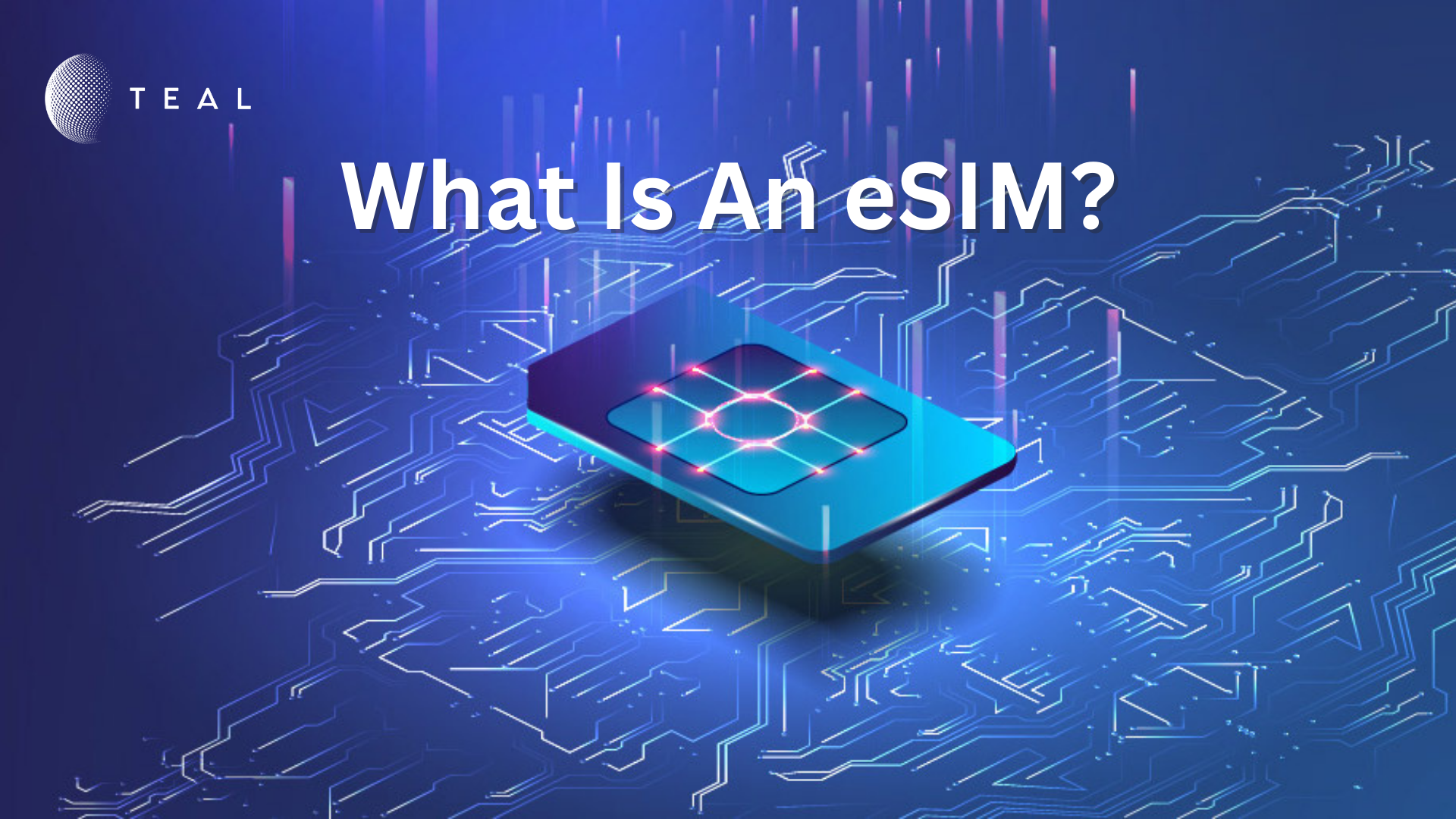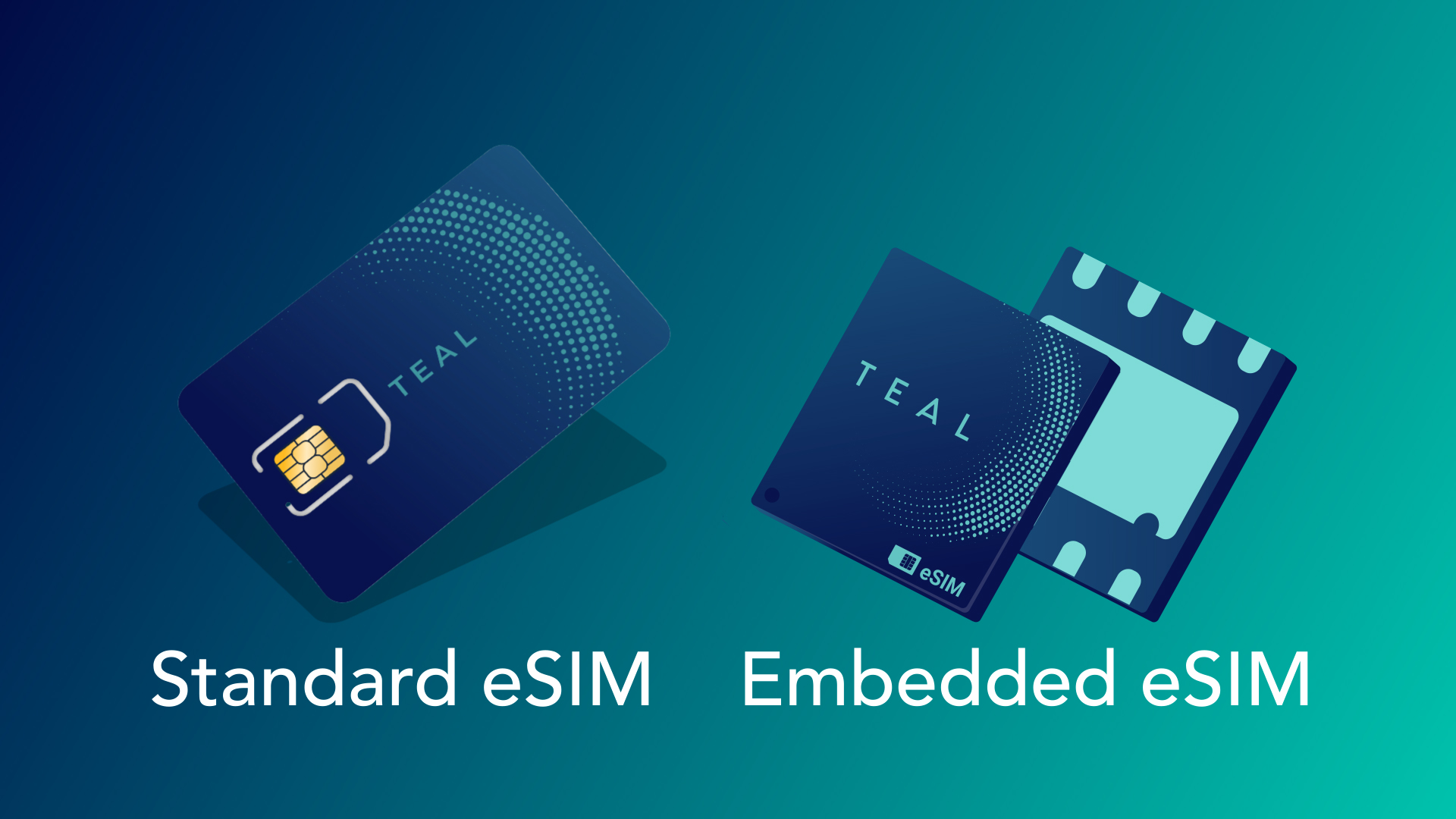What Is An eSIM?

eSIM technology, or “embedded” SIM technology, is quickly becoming the common connectivity standard for connected internet of things (IoT) devices everywhere. From agriculture to smart cities, drones to wearables, eSIMs are being used in a variety of applications and industries. But what exactly is an eSIM? How does it differ from traditional SIM cards? And how can businesses use eSIM technology to their advantage? Let’s explore the answers to these questions and more below.
First off, what is an eSIM?
The ‘e’ stands for embedded. eSIMs come in multiple form factors and are similar to a traditional SIM, as eSIMs can be a physical, insertable chip (2FF/3FF/4FF). However, unlike traditional SIMs, eSIMs can also be soldered onto the motherboard of a device (MFF2). Companies like, Teal offer both plastic eSIM cards (like your standard SIM form factor) and embedded eSIMs that are compatible with any IoT device. This means that users can connect their devices onto any carrier network without having to physically swap out their SIM cards; all they need is access to an available network and the activation process simple. This makes connecting devices directly onto the right networks easier than ever before.
What Are the Advantages of eSIMs?
One of the primary advantages of using eSIM technology versus traditional SIM cards is scalability. With traditional SIM cards, users had to manually switch out the physical SIM cards in their devices or do “truck rolls” if they needed to switch between networks. This required manual intervention on the user’s part and could be time-consuming and difficult if done incorrectly. With true eSIM technology, device operators can switch networks over-the-air (OTA) and dynamically change the identity (i.e. IMSI) of a subscriber remotely. By utilizing a programmable eSIM or eUICC solution, users can easily switch between networks with just a few clicks—no manual intervention needed! Since there are fewer moving parts involved with an eSIM solution, businesses can save time and resources by deploying connected devices faster and more efficiently.
The four pillars of eSIM are:
- Redundancy: No more over-reliance on one provider and its points of failure
- Availability and performance: Delivering low latency, high-throughput anywhere
- Product simplification: No need for multiple versions of devices for markets
- Control and flexibility: Not getting locked into operator agreements
How Is eSIM Technology Being Used Today?

eSIM technology has become increasingly popular over the last few years and is being adopted by various industries due to its scalability and ease-of-use. This includes industries such as agriculture, transportation, smart cities, drones, wearables, autonomous vehicles, healthcare, energy, robotics, manufacturing and others.
Additionally, major mobile phone carriers around the world have started to partner with eSIM connectivity providers like Teal, as the number of IoT devices needing cellular connectivity is growing exponentially. Seamless activation onto carrier networks enabled by eSIM technology means more subscribers for mobile network operators (MNOs). eSIM technology ensures that IoT devices are always connected regardless of where they are in the world.
Examples of How Businesses Have Utilized eSIM Technology Across Many Industries:
- AgTech: Farmers rely on cellular connections for autonomous farm equipment (tractors, weeders) as well as tracking weather and soil with sensors.
- Smart Cities: Sensors are used across cities & communities to monitor environmental conditions as well as energy usage, video cameras deter and monitor crime.
- Autonomous Robots: Delivery robots like those from Starship need reliable connectivity around the world.
- Drones: Beyond Visual Line-of-Sight (BVLOS) drones like those from Volatus Aerospace need programmable access to multiple carrier networks to improve reliability and redundancy.
- Wearables: Secure authentication & encryption help to protect user data from hackers.
- Healthcare: Patients rely on secure connections for access & transfer of medical records.
- Transportation and Mobility: GPS tracking of fleets allows companies to view vehicle locations in real-time and sensors monitor the health of vehicles in order to prevent future maintenance issues.
- Maritime Industry: Connected vessels allow crew members to access vital data while at sea. Hybrid connectivity is essential for the maritime industry.
- Logistics & Utilities Industries: Connectivity helps to manage fleets & maintain infrastructure remotely.
True eSIM Overcomes Common Connectivity Challenges
Leading companies across the globe face similar connectivity challenges that include:
-
Single points of failure and no redundancy
-
Poor availability and roaming restrictions
-
Time and money lost managing multiple connectivity vendors and contracts
-
Concerns about network sunsets, upgrades, and network outages
-
Being locked into networks
True eSIM technology overcomes these challenges and puts businesses in control by giving them the freedom to choose which networks their IoT devices connect to. Thanks to its flexibility, ease-of-use, cost savings potential, security features, and global reach, it’s clear why so many companies have chosen eSIM technology as their preferred connectivity solution.
A single point of failure is a major risk that most businesses don’t often appreciate until they’re faced with a network outage, or network sunset due to network upgrades. With eSIM technology, futureproofing IoT deployments is easy, and companies no longer need to swap out outdated SIMs. Furthermore, enterprises no longer need to manage contracts with multiple connectivity providers to ensure that their devices are reliably connected. With solutions like Teal, businesses only need to manage one eSIM SKU and one bill.
eSIM technology is revolutionizing how businesses connect their devices across various industries throughout the world, by offering reliable connections with minimal effort required from both manufacturers and users alike. If you’re looking to avoid expensive roaming charges, eSIM technology from Teal provides leading companies with a seamless platform to connect any IoT devices onto any global network at the click of a button. Order your eSIMs today!
Learn How TEAL’s eSIM Platform Is Different and Better Than A Mobile Virtual Network Operator (MVNO)
Recent Posts
TEAL’s Network Orchestration Service (NOS) is Changing Cellular Connectivity
Teal Communications Staff2025-07-15T19:59:45+00:00
How TEAL’s eSIM Technology is Shaping the Future of Drone AAM Policy Under FAA Part 108
Teal Communications Staff2025-07-08T16:48:15+00:00
Empowering Freedom, Independence, and Control Through TEAL’s Network Orchestration Service (NOS)
Teal Communications Staff2025-07-03T16:40:46+00:00





